Are you wondering what to do with the surplus of fresh basil leaves from your garden? Explore these versatile and delicious basil recipe ideas that will enhance your culinary adventures.
Key Takeaways:
- Make pesto using fresh basil leaves for a classic and versatile sauce.
- Infuse olive oil or condiments like butter and mayo with basil for added flavor.
- Add fresh basil leaves to salads for a burst of freshness and flavor.
- Try infusing water or other drinks like mojitos, lemonade, and smoothies with basil for a refreshing twist.
- Use basil as a topping for pizza or in appetizers like bruschetta and Caprese skewers.
- Add fresh basil leaves to soups for an extra layer of flavor.
- Preserve basil by drying or freezing it for future use.
- Share your excess basil with friends, family, or neighbors to spread the joy.
Growing and Harvesting Fresh Basil
Before diving into the various ways to use fresh basil, let’s quickly go over how to grow and harvest this fragrant herb, as well as how to store and preserve it for future use.
Growing basil is relatively easy, whether you have an indoor herb garden or an outdoor container garden. Here are some tips to help you successfully grow and harvest fresh basil:
- Choose the right location: Basil thrives in a warm spot that receives at least 6 hours of direct sunlight each day. Whether you grow it indoors or outdoors, make sure it gets enough sunlight.
- Provide well-draining soil: Basil prefers moist, well-draining soil. Make sure the pot or garden bed has good drainage to prevent waterlogged roots.
- Fertilize regularly: Use a balanced 10-10-10 fertilizer and apply it once every 1-2 weeks. This will provide the necessary nutrients for healthy basil growth.
- Harvesting: To harvest fresh basil, simply pull off a few leaves from different spots around the plant and use them in your cooking. If you want to harvest a larger quantity at once, cut the stems from the top of the plant and work your way down.
- Preserving: If you find yourself with an abundance of fresh basil, there are several methods for preserving it. One option is to dry the leaves in a dehydrator and store them in a glass jar for up to a year. Another method is to chop up fresh basil leaves, mix them with olive oil, and freeze the mixture in ice cube trays. This way, you can easily add a cube or two of basil to your recipes during the winter months.
By following these tips, you can enjoy a bountiful harvest of fresh basil and have plenty to use in various dishes throughout the year. Now that you know how to grow and harvest basil, let’s explore the creative ways to use this versatile herb in the kitchen!
Making Pesto
One of the most popular and versatile uses for fresh basil leaves is making pesto, and there are countless delicious variations to try. Pesto is a vibrant and flavorful sauce that can be used in pasta dishes, spread on sandwiches, or drizzled over grilled meats and vegetables. It’s easy to make and a great way to use up a surplus of basil.
To make traditional pesto, you’ll need:
- 2 cups fresh basil leaves
- 1/2 cup grated Parmesan cheese
- 1/2 cup pine nuts or walnuts
- 2-3 cloves of garlic
- 1/2 cup extra-virgin olive oil
- Salt and pepper to taste
Simply combine all the ingredients in a food processor or blender and blend until smooth. If you prefer a chunkier texture, you can pulse the ingredients a few times to leave some texture. Taste and adjust the seasoning as needed. Your homemade pesto is now ready to be used in a variety of delicious dishes.
If you’re feeling adventurous, there are many creative variations of pesto to try:
- Basil-Almond Pesto: Replace the traditional pine nuts with toasted almonds for a nutty twist.
- Basil-Walnut Pesto: Swap out the pine nuts for walnuts to add a rich and earthy flavor.
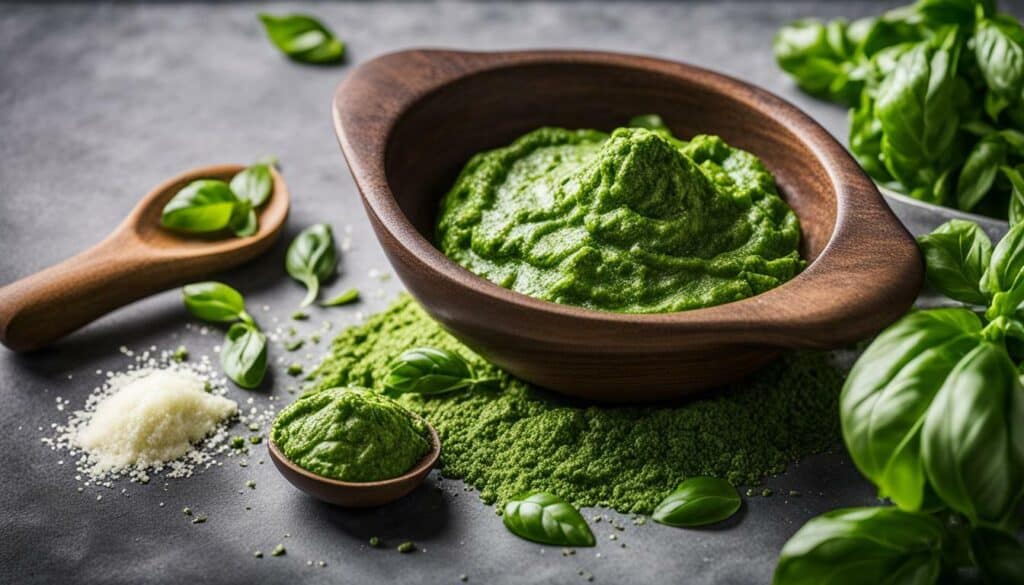
“Pesto requires a large number of fresh basil leaves. Plus, just like the herb, pesto is versatile and delicious!”
Infusing Oils and Condiments
Take your culinary creations to the next level by infusing oils and condiments with the fragrant taste of fresh basil leaves. Basil adds a distinctive flavor and aroma to oils and condiments, elevating your dishes with a touch of freshness and complexity.
“Infusing oils with basil and adding it to condiments like butter and mayo is a great way to enhance their flavor.”
Infusing oils with basil is a simple process that adds a burst of flavor to your cooking. To infuse oil with basil, start by gently blanching a handful of fresh basil leaves in boiling water for a few seconds, then immediately transfer them to an ice bath to preserve their vibrant green color. Pat the leaves dry and place them in a clean glass jar. Fill the jar with your choice of oil, such as olive or grapeseed oil, making sure the leaves are fully submerged. Seal the jar and let it sit at room temperature for about a week to allow the flavors to meld. Strain the oil to remove the basil leaves, and you’ll be left with a delicious basil-infused oil.
Once you have your basil-infused oil, the culinary possibilities are endless. Drizzle it over salads, grilled vegetables, or even pizza for an extra burst of flavor. You can also use it as a marinade for meats or as a dipping sauce for bread.
In addition to infusing oils, you can also incorporate fresh basil leaves into condiments like butter and mayo to add a unique twist. For basil butter, simply finely chop fresh basil leaves and mix them into softened butter. This basil butter can be spread on bread, tossed with pasta, or used to sauté vegetables for a delicious twist. Similarly, for basil mayo, chop up a handful of fresh basil leaves and mix them into mayonnaise along with a dash of fresh garlic. This basil mayo is perfect for sandwiches, burgers, or as a dip for fries.
Infusing oils and condiments with fresh basil allows you to explore new flavors and add a touch of sophistication to your dishes. So why not get creative in the kitchen and start experimenting with basil-infused oils and condiments today?
| Benefits of Infusing Oils and Condiments with Basil |
|---|
| Enhances the flavor of oils and condiments |
| Adds a fresh and vibrant aroma to dishes |
| Allows for creative and personalized culinary creations |
| Provides the health benefits of basil, including antioxidants and other nutrients |
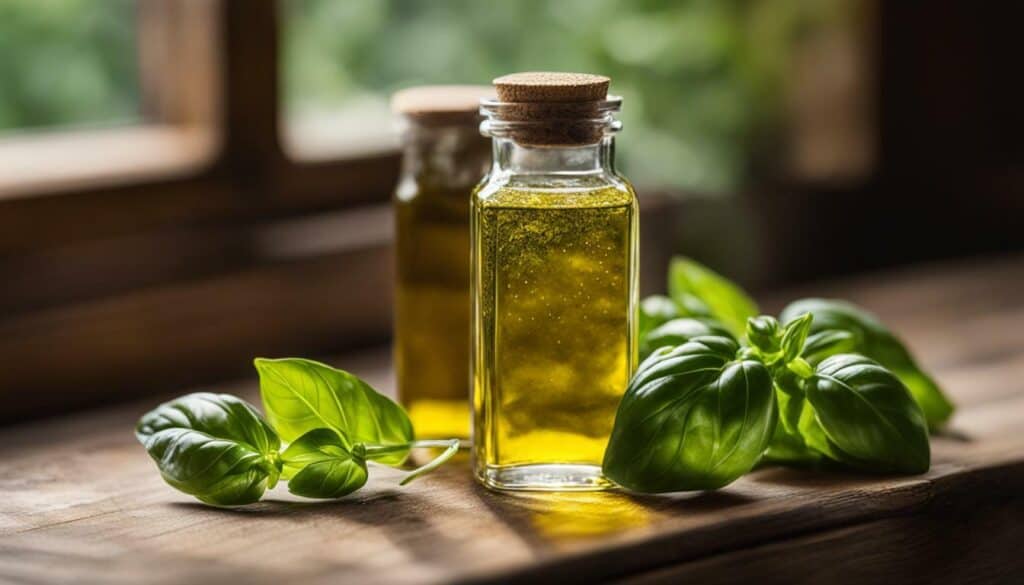
Elevate Your Salads with Fresh Basil Leaves
Elevate your salads with the addition of fresh basil leaves, adding a burst of flavor and freshness to your greens. Basil, with its unique aroma and distinct taste, pairs beautifully with a variety of vegetables, making it a versatile herb to incorporate into your salads. Whether you’re looking to create a classic caprese salad or experiment with unique flavor combinations, fresh basil leaves will take your salads to a whole new level.
Classic Caprese Salad
One of the most iconic salads featuring basil is the classic caprese salad. Layer slices of ripe tomatoes, fresh mozzarella, and whole basil leaves on a platter or plate. Drizzle with extra virgin olive oil, sprinkle with salt and pepper, and finish with a balsamic glaze. The combination of juicy tomatoes, creamy mozzarella, and aromatic basil is a timeless and refreshing salad option.
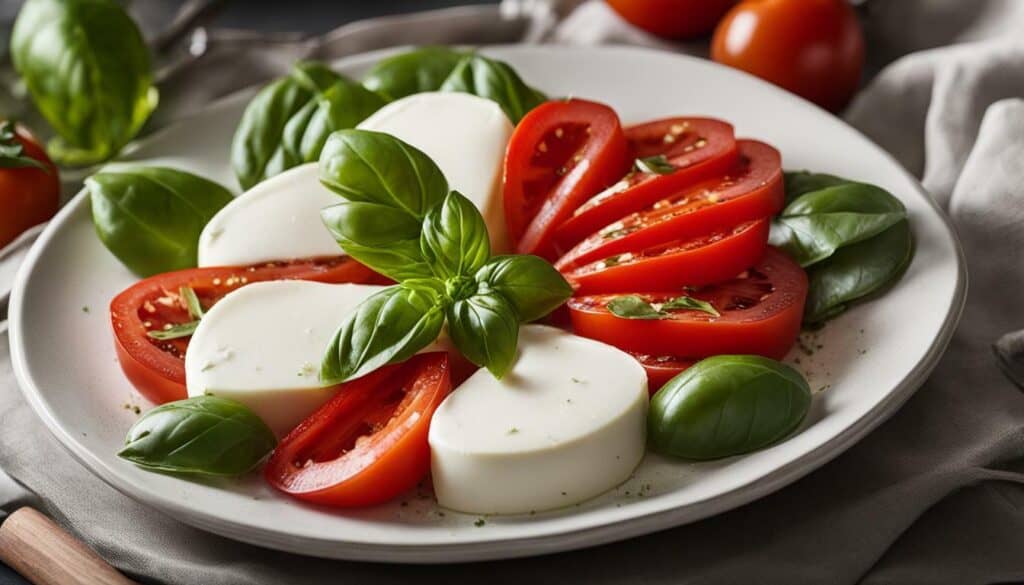
Watermelon and Basil Salad
For a sweeter twist, try adding fresh basil leaves to a watermelon salad. The combination of juicy watermelon, tangy feta cheese, and aromatic basil creates a delightful blend of flavors. Toss the ingredients together in a bowl and finish with a drizzle of balsamic glaze or a splash of lime juice for a refreshing summer salad.
Cucumber, Tomato, and Basil Salad
Another refreshing option is a cucumber, tomato, and basil salad. Slice cucumbers and tomatoes, and then toss them with fresh basil leaves in a bowl. Drizzle with a light vinaigrette made with olive oil, lemon juice, and a touch of honey. This salad is crisp, vibrant, and perfect for a summer picnic or a quick and healthy lunch option.
Basil Caesar Salad
Put a twist on the classic Caesar salad by adding fresh basil leaves to the mix. Prepare a traditional Caesar salad with romaine lettuce, croutons, and Parmesan cheese, but add a handful of torn basil leaves for an extra layer of flavor. The combination of the creamy dressing, crunchy croutons, and aromatic basil will elevate this salad to a whole new level.
- Elevate your salads with the addition of fresh basil leaves
- Classic Caprese Salad: Layer slices of ripe tomatoes, fresh mozzarella, and whole basil leaves
- Watermelon and Basil Salad: Combine juicy watermelon, tangy feta cheese, and aromatic basil
- Cucumber, Tomato, and Basil Salad: Slice cucumbers and tomatoes, then toss them with fresh basil leaves
- Basil Caesar Salad: Add torn basil leaves to a traditional Caesar salad
These are just a few ideas to inspire you to incorporate fresh basil leaves into your salads. The possibilities are endless, so get creative and enjoy the burst of flavor and freshness that basil brings to your greens.
“Basil, with its unique aroma and distinct taste, pairs beautifully with a variety of vegetables, making it a versatile herb to incorporate into your salads.”
Infused Water and Other Drinks
Quench your thirst with basil-infused water or elevate your favorite drinks with the unique flavor of fresh basil leaves. Basil adds a refreshing and aromatic twist to beverages, making them even more enjoyable on hot summer days.
Infused water is a simple and healthy way to stay hydrated while delighting your taste buds. To make basil-infused water, simply add a few fresh basil leaves to a pitcher of water and let it steep for a few hours in the refrigerator. The result is a subtly flavored and refreshing drink that is perfect for staying hydrated.
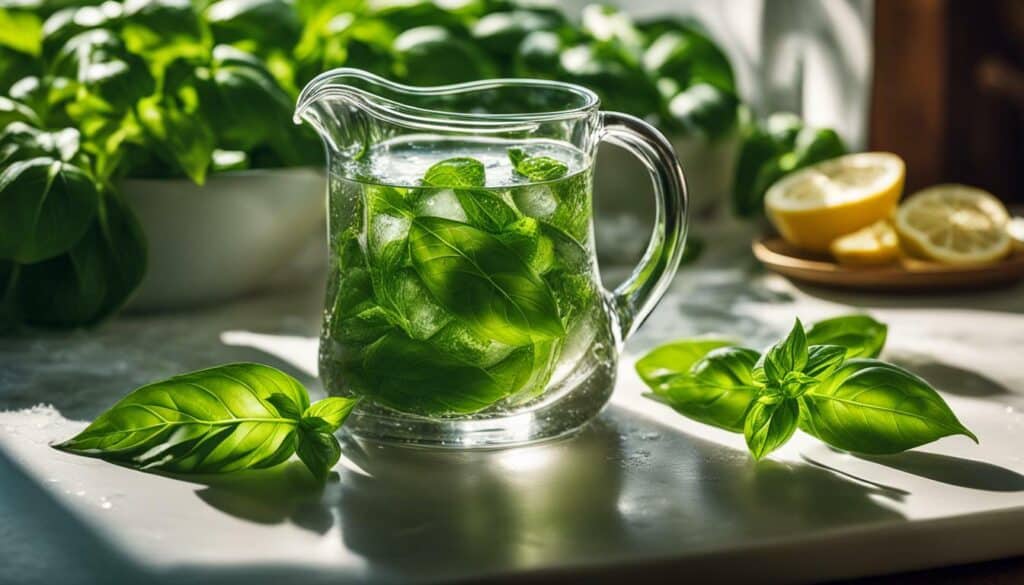
If you’re looking for something a bit more indulgent, try incorporating basil into other drinks. Basil can add a unique and delicious twist to a variety of beverages, both alcoholic and non-alcoholic.
If you enjoy boozy drinks, consider adding basil to your mojitos. The combination of fresh mint and basil creates a harmonious blend of flavors that is sure to please. You can also experiment with other cocktails and mocktails by muddling basil leaves with fruits and adding them to your drink.
For a family-friendly option, try making a refreshing basil lemonade. Simply combine freshly squeezed lemon juice with a basil-infused simple syrup and water. The result is a tangy and herb-infused beverage that is perfect for quenching your thirst.
If you’re a fan of smoothies, consider adding basil to your favorite blend. Basil pairs well with various fruits, such as strawberries, blueberries, and watermelon, adding a refreshing twist to your smoothie.
With these creative drink ideas, you can enjoy the unique flavor of fresh basil while staying hydrated and cool during the summer months.
Add a burst of flavor and a touch of elegance to your favorite pizza and appetizers with the addition of fresh basil leaves.
Basil is a versatile herb that can take your pizza and appetizers to the next level. Its fragrant aroma and distinct flavor add a burst of freshness to any dish. Whether you’re making a classic Margherita pizza or serving up some mouthwatering appetizers, fresh basil leaves are a must-have ingredient.
Here are a few creative ways to use fresh basil leaves in your pizza and appetizers:
- Caprese Pizza: Create a delicious Caprese pizza by topping your dough with fresh mozzarella, sliced tomatoes, and a generous amount of torn basil leaves. Bake until the cheese is melted and bubbly, and the basil leaves are slightly wilted.
- Basil Bruschetta: Whip up a batch of classic bruschetta by combining diced tomatoes, minced garlic, fresh basil leaves, olive oil, and balsamic vinegar. Spread the mixture on toasted baguette slices for a delightful appetizer.
- Caprese Skewers: Thread cherry tomatoes, mini mozzarella balls, and small basil leaves onto skewers for a bite-sized appetizer that’s perfect for parties. Drizzle with balsamic glaze for an extra touch of sweetness.
- Basil Pesto Dip: Blend fresh basil leaves, pine nuts, garlic, Parmesan cheese, and olive oil in a food processor until smooth to create a flavorful basil pesto dip. Serve with breadsticks, crackers, or fresh vegetables.
Not only do fresh basil leaves add a pop of color to your dishes, but they also bring a depth of flavor that complements other ingredients perfectly. The combination of tomatoes, mozzarella, and basil in Caprese-inspired recipes is a match made in heaven. The aromatic basil leaves enhance the flavors of the pizza and appetizers, making every bite a true delight.

So next time you’re making pizza or appetizers, don’t forget to add some fresh basil leaves. It’s an easy way to elevate your dishes and impress your guests with the vibrant flavors of summer.
Take your soups to the next level with the addition of fresh basil leaves and learn how to preserve your excess basil for later use.
When it comes to enhancing the flavors of soups, fresh basil leaves are a game-changer. The aromatic and slightly sweet taste of basil adds a refreshing and vibrant note to any soup recipe. Whether you’re making a classic tomato soup or a hearty vegetable stew, adding fresh basil leaves will take your soups to the next level.
But what if you find yourself with an abundance of fresh basil leaves? Don’t worry, you can easily preserve your excess basil for later use, ensuring that you can enjoy the flavors of this versatile herb all year round.
There are a couple of methods you can use to preserve your basil:
Drying Basil
Drying basil is a simple and effective way to preserve it. To dry basil, start by plucking the leaves from the stems. Wash and pat them dry with a clean towel. Then, spread the basil leaves out in a single layer on a baking sheet lined with parchment paper. Place the baking sheet in a cool, dry place and let the basil leaves air dry for about a week, or until they are completely dry and crumbly.
Once the leaves are dry, you can store them in an airtight container or a glass jar for up to a year. Dried basil can be used in soups, stews, sauces, and other recipes where fresh basil may not be available.
Freezing Basil
Freezing basil is another great way to preserve its vibrant flavor. To freeze basil, start by blanching the leaves in boiling water for about 10 seconds, then immediately transfer them to an ice bath to stop the cooking process. Once cooled, pat the leaves dry and place them in a single layer on a baking sheet. Pop the baking sheet in the freezer for a couple of hours until the basil leaves are frozen.
Once the leaves are frozen, transfer them to a freezer-safe container or bag and store them in the freezer. Frozen basil can be added directly to soups and sauces without thawing, making it a convenient option for quick and easy flavor enhancement.
Now that you know how to preserve your excess basil, let’s explore some delicious soup recipes that will benefit from the addition of fresh basil:
Tomato Basil Soup
There’s nothing quite like a bowl of creamy tomato basil soup. The combination of ripe tomatoes, fragrant basil, and a touch of cream creates a comforting and flavorful soup that’s perfect for any time of the year. Try this recipe for a classic tomato basil soup:
Ingredients:
- 2 tablespoons olive oil
- 1 onion, diced
- 4 cloves of garlic, minced
- 4 cups fresh tomatoes, diced
- 1 cup vegetable broth
- 1/2 cup fresh basil leaves, chopped
- 1/4 cup heavy cream
- Salt and pepper to taste
Instructions:
- In a large pot, heat the olive oil over medium heat. Add the onion and garlic and sauté until softened.
- Add the diced tomatoes and vegetable broth to the pot. Bring to a boil, then reduce heat and simmer for about 20 minutes.
- Remove the pot from heat and let it cool slightly. Using an immersion blender or a regular blender, blend the soup until smooth.
- Return the soup to the pot and stir in the chopped fresh basil leaves and heavy cream. Season with salt and pepper to taste.
- Simmer the soup for another 5 minutes to allow the flavors to meld together.
- Serve hot and garnish with additional fresh basil leaves if desired.
This tomato basil soup is perfect for a cozy night in or as a starter for a dinner party with friends. The addition of fresh basil leaves adds a burst of flavor and freshness to the soup.
So, next time you find yourself with an abundance of fresh basil leaves, don’t let them go to waste. Use them to elevate your soups and preserve the flavors of this versatile herb for future cooking adventures.

With these creative ideas and recipes, you can make the most of your fresh basil leaves and enhance your culinary adventures with their delightful flavor.
When you find yourself with an abundance of fresh basil leaves from your garden, it’s time to get creative and explore all the wonderful ways you can use this aromatic herb. From classic pesto to infused oils and condiments, there are endless possibilities to elevate your dishes with the vibrant taste of basil.
Make Pesto
Making pesto is a popular choice for using up a surplus of basil. This versatile sauce requires a large number of fresh leaves and can be enjoyed on pasta, sandwiches, or as a dip. Traditional pesto with basil, garlic, pine nuts, Parmesan cheese, and olive oil is a go-to option. For a twist, try variations like basil-almond pesto or basil-walnut pesto.
Infuse Oils and Condiments
Basil can also be infused into oils to add a burst of flavor to your dishes. Simply heat olive oil and add fresh basil leaves, allowing them to steep until the oil becomes fragrant. You can use the infused oil in dressings, marinades, or drizzle it over roasted vegetables. Additionally, basil can be chopped and mixed with butter or mayo to create deliciously infused condiments.
Adding Basil to Salads
Fresh basil leaves are a wonderful addition to salads, bringing a refreshing and aromatic element to your greens. Classic caprese salads, featuring tomatoes, mozzarella, and basil leaves, are always a crowd-pleaser. For a sweeter twist, try tossing fresh basil into fruit-based salads with watermelon or other melons.
Infused Water and Other Drinks
Basil can be used to infuse water with a subtle and refreshing flavor. Simply add a few basil leaves to a pitcher of water and let it steep for a few hours before enjoying. For a more elevated beverage experience, incorporate basil into various drinks like mojitos, lemonade, or smoothies. The herbal notes of basil complement the flavors of these drinks and add a unique twist.
Basil in Pizza and Appetizers
One of the most beloved ways to use fresh basil leaves is as a topping for pizza. The combination of tomatoes, mozzarella, and basil creates a harmonious flavor profile that is simply irresistible. Additionally, you can incorporate basil leaves into finger foods and appetizers like bruschetta or Caprese skewers. These bites are perfect for entertaining or as a quick snack.
Basil in Soups and Preserving Methods
Basil can elevate the flavor of soups, especially tomato-based or vegetable soups. Simply chop fresh basil leaves and add them to your simmering soup for a burst of herbal goodness. If you find yourself with an excess of basil and want to preserve it for later use, there are several methods to consider. You can dry the leaves in a dehydrator or freeze them in olive oil using ice cube trays. These preserved basil options will keep the fresh taste of basil alive throughout the year.
Conclusion
With its versatile flavor and abundance of health benefits, fresh basil leaves are a fantastic addition to any kitchen. Whether you choose to make pesto, infuse oils, add it to salads, or experiment with other creative uses, fresh basil leaves can enhance your culinary creations and bring a touch of summer to your dishes. Don’t let your excess basil go to waste; explore these recipes and enjoy the benefits of this aromatic herb in your cooking.
FAQ
Q: How do I store fresh basil to keep it fresh?
A: Trim the stems and place the basil in a glass of water. Cover it loosely with a plastic bag and store it at room temperature.
Q: Can I freeze basil?
A: Yes, you can freeze fresh basil either by blanching and freezing the leaves individually or by blending them with olive oil and freezing them in ice cube trays.
Q: What can I make with fresh basil?
A: Some ideas include making pesto, infusing oils and condiments, adding basil to salads, using it in pizza and appetizers, incorporating it into soups, and preserving it for later use.
Q: How long does fresh basil last?
A: If stored properly, fresh basil can last for about a week or two.
Q: Can I use dried basil instead of fresh?
A: While dried basil can be used as a substitute, it doesn’t have the same flavor and aroma as fresh basil.
What Are Some Recipes or Dishes That Can Be Made with Fresh Basil Leaves?
Fresh flavors with basil today can be explored through various recipes and dishes. One popular option is to create a classic Caprese salad by layering juicy tomatoes, creamy mozzarella, and vibrant basil leaves, finished with a drizzle of olive oil. For a main course, pasta dishes like pesto pasta or homemade tomato sauce infused with basil can bring out the herb’s aromatic essence. Additionally, basil can be used to make deliciously refreshing lemonade or infused into homemade ice cream for a unique twist.

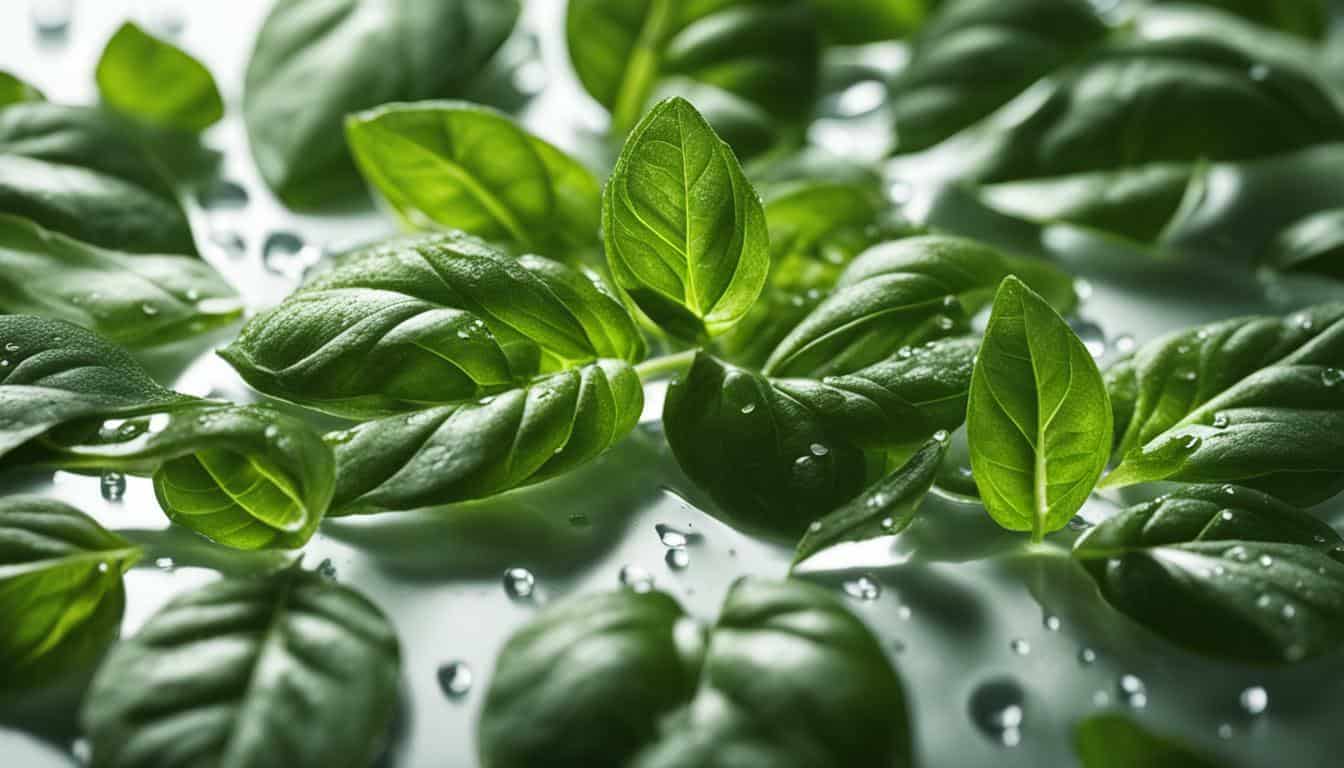



Leave a Reply